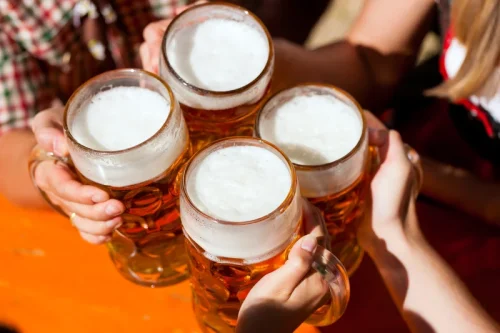Like other health issues, alcohol use can be linked to a complex array of factors ranging from individual-level (i.e., genetics) to population-level (i.e., cultural and societal factors) characteristics (Berkman et al. 2000; Krieger 2001; Link and Phelan 1995). On a population level, emerging research has documented the relationship between social determinants and health (Berkman and Kawachi 2000; Berkman et al. 2000) and, specifically, the social epidemiology of alcohol use (Bernstein et al. 2007; Galea et al. 2004). Social capital theory suggests that social networks and connections influence health (Berkman et al. 2000).
Alcohol dependency disorder by country
Contact emergency services immediately if you experience symptoms such as fever, involuntary muscle contractions, seizures, delusions, hallucinations, or rapid mood swings as you withdraw from alcohol. Before you decide to stop drinking, talk to a healthcare provider to determine what treatment options are available and whether you would benefit from medical supervision during detox. Hosted by therapist Amy Morin, LCSW, this episode of The Verywell Mind Podcast shares strategies for coping with alcohol cravings and other addictions, featuring addiction specialist John Umhau, MD. According to a study published in the journal Preventing Chronic Disease, 90% of people who abuse alcohol are not alcohol dependent. Alcohol-related deaths in Vermont are average, but under-21 deaths are among the lowest nationwide.
What is a standard drink measure?
In the chart, we see the average consumption (in liters of ethanol) of different beverage types per person in the USA since the mid-nineteenth century. Many people with AUD do recover, but setbacks are common among people in treatment. Behavioral therapies can help people develop skills to avoid and overcome triggers, such as stress, that might lead to drinking. Medications also can help deter drinking during times when individuals may be at greater risk of a return to drinking (e.g., divorce, death of a family member).
Emerging Trend—High-Intensity Drinking
- This report presents overall and sex-specific trends in alcohol-induced death rates from 2000 to 2020, and then focuses on the rates for 2019 and 2020 by sex, age group, and underlying cause of death.
- The role of discrimination and stress in health-related risk behaviors, including alcohol use, is well established (Dawson et al. 2005; Hatzenbuehler 2009; Paradies 2006).
- Alcohol use also is a risk factor for pancreatitis, gastritis, gastro-esophageal reflux disease and peptic ulcer disease, as well as a potential aggravator of mental and behavioral disorders.
- Among immigrants, retaining the cultural values of the country of origin has shown to have protective influences on alcohol use, and this finding should be incorporated into future interventions for immigrant populations.
Past studies suggest that African Americans with higher levels of education were more likely to report experiencing discrimination, whereas the opposite was true among Whites (Borrell et al. 2007; Krieger et al. 1998). This may be because better educated African Americans find themselves in situations in which they may be exposed to discrimination, or they may be more acutely aware of how subtly it can be expressed. Whites of lower SES may be in the minority and therefore may be more likely to report experiencing discrimination.
What Is Alcohol Dependence?
Additionally, not all baseline respondents completed wave 2, although nonrespondents did not significantly differ from completers on any of the outcome measures at baseline. Nonetheless, these results suggest that examination of whether increases in alcohol use persist as the pandemic continues and whether psychological and physical well-being are subsequently affected may be warranted. Individual-level factors that influence alcohol use are nested within home, work, and school environments, which are nested within the larger community. Macro-level factors, such as exposure to advertising, may influence family and peer network attitudes and norms, which ultimately affect individual attitudes and behaviors. In the past month, half of them did not drink alcohol, according to federal data.
Treatments That Can Help
Studies consistently report that alcohol accounts for over 75,000 U.S. cancer cases and 20,000 cancer deaths each year. Among women who are pregnant, up to 14% report currently drinking, according to CDC data. Some studies have found that LGBTQ+ people have higher rates of alcohol use, and are at higher risk of developing an alcohol use disorder.
Statistics indicate Georgia has a higher rate of underage drinkers than the majority of states. Children aged 17 years and younger are much more likely to live with an alcoholic parent than they are to be diagnosed with a learning disability or ADHD. It can be hard to see there is a problem even if the drinking is negatively impacting your health and your life. If you have a concern that you have AUD, you can see a health professional for consultation. All authors have completed and submitted the International Committee of Medical Journal Editors form for disclosure of potential conflicts of interest.
Alcohol use disorder treatment
- The language used in the past often served to stigmatize people who are affected by alcohol use disorder.
- That is, the longer immigrants have lived in the United States, the more likely they are to acculturate to the cultural norms of their destination community (Berry et al. 2006).
- If AUD is not treated, it can increase your risk for serious health problems.
If you have a history of withdrawal symptoms, see a health professional before quitting. You should also see a professional before quitting alcohol if you have other health conditions. Another complication is alcohol withdrawal syndrome, which may occur after you stop drinking and can cause symptoms such as nausea, shaking, and sweating. It can also lead to serious symptoms like seizures, fever, or hallucinations, and can be a medical emergency.
Behavioral Treatments
- This topic page looks at the data on global patterns of alcohol consumption, patterns of drinking, beverage types, the prevalence of alcoholism, and consequences, including crime, mortality, and road incidents.
- Billboards and other advertisements for malt liquor are disproportionately found in neighborhoods with higher percentages of African Americans, and rap music lyrics frequently mention malt liquor (Herd 2013; McKee et al. 2011).
- Individuals who have higher levels of social support and community cohesion generally are thought to be healthier because they have better links to basic health information, better access to health services, and greater financial support with medical costs.
But other numbers — data from study after study — give a more clear-eyed view of Americans’ drinking lives and the ripple effects. We also find correlates in drinking patterns when we look at groupings of income, education or work status. Although those distinguish between alcohol abuse and alcoholism in lower income or educational status groups often drink less overall, they are more likely to have lower-frequency, higher-intensity drinking patterns. Overall, these groups drink less, but a higher percentage will drink heavily when they do.




